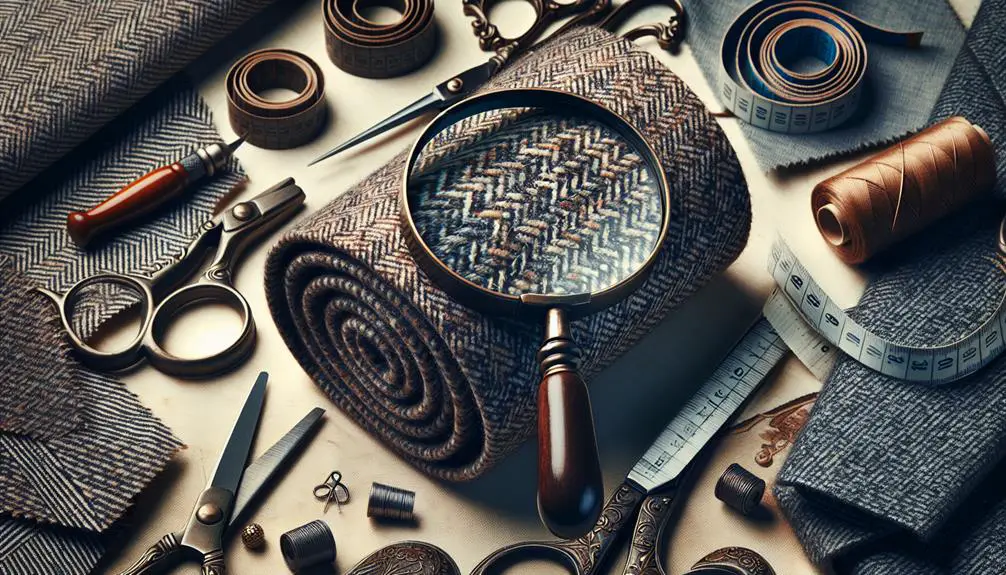Ever wondered why tweed is often seen as a pricier option when you're out shopping for new threads? I've always been curious about what exactly makes it so special. From its origins in Scotland to the complex way it's woven, tweed's got a backstory that justifies its cost. It's not just about the material itself but the craftsmanship and the sustainable practices that go into creating each piece. But here's the kicker: is the higher price tag of tweed truly worth it? Let's unpack the reasons behind its luxury status and see if it's more than just a fashion statement.
Table of Contents
Key Takeaways
- Tweed's complex production process, involving manual weaving and finishing, contributes to its higher cost.
- The use of premium materials such as durable local wool and luxury blends like silk or cashmere increases expenses.
- Sustainable manufacturing practices, aimed at minimizing environmental impact, often result in higher production costs.
- The skill of traditional weavers, crucial for maintaining tweed's quality, significantly impacts labor costs.
- The fabric's cultural significance and popularity in high fashion also drive up its market price.
History of Tweed
Tweed's origins trace back to the Scottish Outer Hebrides, where it was first woven by islanders to withstand the harsh, cold climate. This rugged beginning is a key chapter in the fabric's history, giving it a legacy of durability and protection. Over time, tweed evolved from a practical necessity to a symbol of sophisticated rural style, rich with folklore and tradition.
The allure of tweed is boosted by numerous celebrity endorsements, which weave together the old-world charm with modern prestige. Icons like Sean Connery and fashion giants such as Coco Chanel have donned tweed, elevating its status from mere material to a fashion statement with aristocratic flair. This blend of practicality and luxury captures the essence of tweed, making it more than just a fabric but a cultural icon.
Tweed folklore often highlights its accidental discovery or its use in historical garments. These tales contribute to the mystique and desirability of tweed, emphasizing its roots in survival and adaptation. As a fabric that has clothed fishermen and inspired designers, tweed holds a unique position in both utility and haute couture, making it a timeless choice in the world of fashion.
Sources and Origins
Delving into the sources and origins, tweed primarily hails from the Scottish Isles, where local resources and traditional techniques fuse to craft this distinctive fabric. The rugged landscape and climate of regions like the Outer Hebrides play an important role in shaping the characteristics of tweed. The local sheep breeds provide the wool, which is renowned for its durability and warmth, making it an ideal base for the fabric blends typical in tweed production.
Now, let's talk about those fabric blends. They're not just about mixing different types of wool. Manufacturers often incorporate materials like silk or cashmere to enhance the texture and functionality of the tweed. This blending not only tailors the fabric to various uses, from sturdy outdoor wear to refined fashion items, but it also impacts the overall cost of the material.
Concerning environmental impact, the production of tweed in its traditional locales tends to lean on more sustainable practices. These communities have a vested interest in maintaining the health of their land, as it directly affects the quality of their primary resource: wool. Therefore, the manufacturing processes often emphasize ecological balance, aiming to minimize waste and chemical usage. This sustainable angle can add to the fabric's appeal but also to its expense.
Manufacturing Process
Let's explore how tweed is made, beginning with the initial shearing of sheep. This first step is important as it sets the foundation for the quality of the tweed. Once the wool is sheared, it undergoes a series of steps to transform into the durable, yet stylish fabric we recognize.
Here's a quick rundown of the key stages:
- Spinning: The wool fibers are cleaned and spun into yarn. This process is labor-intensive but essential for ensuring the strength and consistency of the tweed.
- Weaving: The yarn is then woven on looms. The patterns and the tightness of the weave vary, impacting the texture and the final look of the tweed.
- Finishing: Finally, the fabric is washed, dried, and sometimes teased to raise the surface fibers, enhancing the characteristic tweed texture.
During each of these stages, the environmental impact and labor conditions are critical concerns. The textile industry, including tweed production, can be resource-intensive, often requiring significant amounts of water and energy. Additionally, ensuring fair labor conditions in the mills is paramount to producing ethically made tweed. As a fabric enthusiast, understanding these aspects helps me appreciate the true cost and value of tweed beyond just its price tag.
Types of Tweed
Now, let's talk about the different types of tweed out there.
We'll start by exploring where various tweed varieties come from.
Then, we'll look at some of the most popular patterns you might recognize.
Origins of Tweed Varieties
Exploring the origins of tweed varieties, we find a rich tapestry of styles each with its unique story. Tweed designers have long drawn inspiration from the landscapes and cultural heritage of their regions, weaving these elements into their fabrics. The influence of geography is unmistakable in the textures and patterns that characterize different types of tweed.
- Harris Tweed: Directly from Scotland's Outer Hebrides, its authenticity is protected by law, ensuring it's made from local wool.
- Donegal Tweed: Known for its colorful speckled patterns, this Irish tweed reflects the natural beauty of its namesake county.
- Saxony Tweed: Originating from Germany, it's finer and softer, often preferred for more luxurious garments.
Each variety tells a story, deeply rooted in its regional influences and the creative visions of its designers.
Popular Tweed Patterns
Lastly, the world of tweed offers various patterns that stand out for their unique appeal and historical significance. Herringbone is instantly recognizable with its broken zigzag pattern. It's not just for suits; this design has been a hit in tweed accessories too.
Then there's the classic check, featuring crisscrossing lines that vary in width. It's been popularized by numerous designer collaborations, ensuring tweed remains trendy in modern fashion circles.
Tartan tweed, with its cross-hatched multicolored bands, reflects traditional Scottish heritage and is a staple in both apparel and accessories.
Modern Tweed Applications
Tweed isn't just for classic suits; it's also made its way into everything from modern jackets to trendy bags. I've seen an incredible variety of tweed applications that blend tradition with cutting-edge style. Designers are innovating, using tweed in ways that really push the envelope.
- Tweed accessories: From chic hats and scarves to stylish wallets and belts, tweed adds a touch of class and durability.
- Fashion collaborations: High-end brands are partnering with traditional tweed weavers, creating unique, must-have pieces.
- Home decor: Tweed upholstery on sofas and chairs brings a warm, luxurious feel to interior designs.
These modern uses showcase tweed's versatility and enduring appeal, proving it's a fabric that transcends its old-school roots.
Cost Factors
Let's talk about what makes tweed potentially pricey.
The complexity of its production process can really drive up costs. Plus, the prices of the raw materials used also play a big role in how much you end up paying.
Production Process Complexity
One major factor driving up the cost of tweed is its complex production process. This isn't just about weaving threads; it's a detailed craft that demands skilled labor and mindful practices. Here's what ramps up the expenses:
- Skilled Weavers: The expertise required to weave tweed is significant. Artisans need to be highly trained, impacting labor costs.
- Environmental Practices: Sustainable methods are integrated to minimize environmental impact, often requiring more expensive techniques and materials.
- Manual Processes: Many steps in tweed production are done manually to guarantee quality, from dyeing to finishing.
These elements guarantee the fabric's uniqueness and quality but also contribute to its higher price point, reflecting the careful balance of ethical labor practices and environmental considerations.
Raw Material Prices
Another significant factor in tweed's cost is the price of its raw materials, which are often premium and scarce. The primary material, wool, typically comes from specific breeds of sheep known for their quality fibers. However, the availability of this wool can vary, leading to price fluctuations that directly impact the cost of tweed.
Additionally, the competition among suppliers for these high-quality materials can further drive up prices. It's not just about finding wool, but securing the best sources that meet the high standards required for premium tweed. This competition isn't just local but global, adding another layer of complexity to the pricing. Understanding these dynamics is key to grasping why tweed often comes with a higher price tag.
Durability and Quality
Tweed's durability makes it a standout choice for long-lasting clothing. As someone who's extensively explored various textiles, I can tell you that the quality of tweed is exceptional. It's not just about looking good; it's about investing in a fabric that holds up over time, resisting wear and tear like a champ.
When it comes to tweed, you're getting a material that's robust enough to handle whatever you throw at it. Here's why:
- Resistant to Snagging and Pilling: Unlike some finer fabrics, tweed is woven tightly enough that it doesn't easily snag or start looking bobbly after a few wears.
- Maintains Shape: The natural elasticity of the wool used in tweed means it tends to keep its shape, resisting stretches and sags.
- Adaptable to Weather: Tweed is famously warm, but it's also breathable. This makes it ideal for various climates, from chilly winds to mild breezes.
Exploring the texture analysis, tweed offers a unique feel that's both rustic and refined. Its color variations are another huge plus. From muted earth tones to vibrant checks, tweed ensures that each piece is distinctly its own. This isn't just fabric; it's a craft.
Market Demand
Now, let's talk about why tweed's gotten so popular all over the world.
It seems like everyone's buying tweed, especially when the weather turns chilly.
This trend really drives up the price, making tweed a bit more of a luxury.
Global Popularity Surge
In recent years, tweed has skyrocketed in popularity across the globe, driven by its unique charm and versatility. Celebrity endorsements have played a huge role, with stars donning tweed on red carpets and in everyday fashion, making it more desirable. Additionally, high-profile fashion collaborations have introduced tweed to broader audiences, integrating it into modern and high-street fashion.
Here's what's fueling the surge:
- Celebrity Influence: Top celebrities wearing tweed boosts its visibility and appeal.
- Fashion Collaborations: Exclusive partnerships with major fashion brands reinvigorate tweed's image.
- Global Appeal: Tweed has transcended its traditional British roots, appealing to fashion-forward individuals worldwide.
This blend of traditional fabric with contemporary culture has truly globalized tweed's appeal.
Seasonal Buying Trends
Seasonal buying trends reveal that I'm not the only one snapping up tweed in the cooler months, as it becomes a go-to material for both fashion and function. The weather influence can't be ignored. As temperatures drop, the demand for tweed rises, not just among the fashion-conscious but also among those seeking warmth and durability. Tweed's unique properties make it ideal for resisting the chill, which clearly drives its seasonal popularity.
Consumer demographics shift significantly too. Younger urbanites are adopting this traditionally rural fabric, blending it into modern wardrobes. Meanwhile, older generations continue to value tweed for its timelessness and quality. This dual appeal ensures a consistent market demand, keeping tweed prominent in many closets as the leaves start to turn.
Comparisons With Other Fabrics
When comparing tweed to other fabrics, it's evident that its unique qualities set it apart in both style and cost. Tweed, traditionally woven from wool, offers both durability and a timeless aesthetic that many synthetic fabrics can't match. Let's break down how tweed stands out:
- Fabric Sustainability: Tweed is inherently more sustainable than many man-made fibers. It's made from natural wool, which is biodegradable and renewable. This aspect is vital for those of us who prioritize environmental impact in our fashion choices.
- Color Variations: Unlike some fabrics that fade quickly, tweed's color variations are rich and deeply integrated into the weave. This means they maintain their vibrancy over time, offering a better long-term appearance.
- Texture and Weight: Tweed's texture is unmistakable; its weight and feel convey quality. While lighter fabrics like cotton or synthetic blends might offer breathability, they often lack the robust texture that adds character to tweed garments.
In essence, if you're looking for a fabric that combines style, sustainability, and enduring appeal, tweed is a standout choice. Its qualities reflect a blend of tradition and modernity, making it a smart investment for those who care about both aesthetics and environmental impact.
Maintenance and Care
Caring for tweed requires some specific steps to maintain its unique texture and longevity. First off, let's talk about cleaning techniques. I don't usually machine wash my tweed items; it can be too harsh on the fabric. Instead, I opt for gentle spot cleaning or, if necessary, dry cleaning. This approach helps preserve the fibers and prevents the tweed from losing its exceptional texture.
Now, when it comes to storage solutions, I've learned a few tricks to keep my tweed looking great. Always store tweed garments in a cool, dry place. Humidity is the enemy here—it can lead to mold or mildew, which is the last thing you want. I use padded hangers to maintain the shape of the jackets and avoid creasing. For long-term storage, I prefer breathable garment bags. These protect the tweed from dust and pests without trapping moisture like plastic can.
Taking these steps has really helped me keep my tweed in excellent condition. It's all about treating the material with a bit of care and respect. After all, a well-maintained piece of tweed clothing can last for decades, becoming a timeless addition to your wardrobe.
Cultural Significance
Tweed holds a special place in fashion history, symbolizing both tradition and rebellion. It's not just a fabric; it's a narrative woven into the very fabric of style, crossing boundaries from rugged landscapes to high-end fashion shows. Here's why it's more than just material—it's a cultural icon.
- Historical Roots: Tweed began as practical attire for Scottish and English farmers, designed to protect against harsh weather. It was durable, water-resistant, and snug, making it ideal for outdoor work.
- Fashion Evolution: By the 20th century, tweed had shifted from farm fields to the wardrobes of the elite, becoming a staple in the collections of top designers. It's been reimagined in countless iconic garments, showcasing its versatility and timeless appeal.
- Symbolic Rebelliousness: Tweed has also played a role in subcultural movements. Think of the 60s mods and the punk era of the 70s; tweed was there, tweaked and styled to symbolize rebellion against the mainstream.
Tweed's journey from practicality to high fashion highlights its unique place in culture. It's not just about keeping warm anymore; it's about making a statement. Whether on the runway or the streets, tweed remains as relevant as ever, celebrated in fashion shows across the globe. It's truly a reflection of the enduring appeal of quality craftsmanship and style.
Frequently Asked Questions
Can Tweed Be Dyed at Home Effectively?
Yes, I can dye tweed at home, but it's challenging. I'd focus on proper dyeing techniques and ensuring color fastness to avoid uneven shades. It's essential to use the right type of dye.
Is Tweed Considered Eco-Friendly?
I've learned that tweed production can be eco-friendly if it involves sustainable sourcing. However, not all tweed is created equal, so it's important to research how the tweed was sourced and produced.
How Does Tweed React to Different Weather Conditions?
Tweed's great for various climates because it's insulating and moisture-resistant. It keeps me warm in the cold and stays relatively dry in damp weather. Perfect for staying comfy and stylish, no matter the forecast!
Are There Hypoallergenic Tweed Options Available?
Yes, there are hypoallergenic tweed options available that cater to fabric allergies. These alternatives guarantee everyone can enjoy tweed without discomfort, maintaining both style and health-consciousness in their wardrobe choices.
Does Tweed Offer UV Protection?
I've found that tweed's fabric thickness can indeed offer some UV protection. However, its effectiveness varies with the UV intensity and the weave's density. It's not foolproof, but it's better than nothing!
- How Does Ring Spun Cotton Affect Garment Fit and Shape Retention? - August 13, 2024
- What Are the Challenges in Producing Ring Spun Cotton? - August 13, 2024
- Is Ring Spun Cotton Suitable for Plus-Size Clothing? - August 13, 2024







